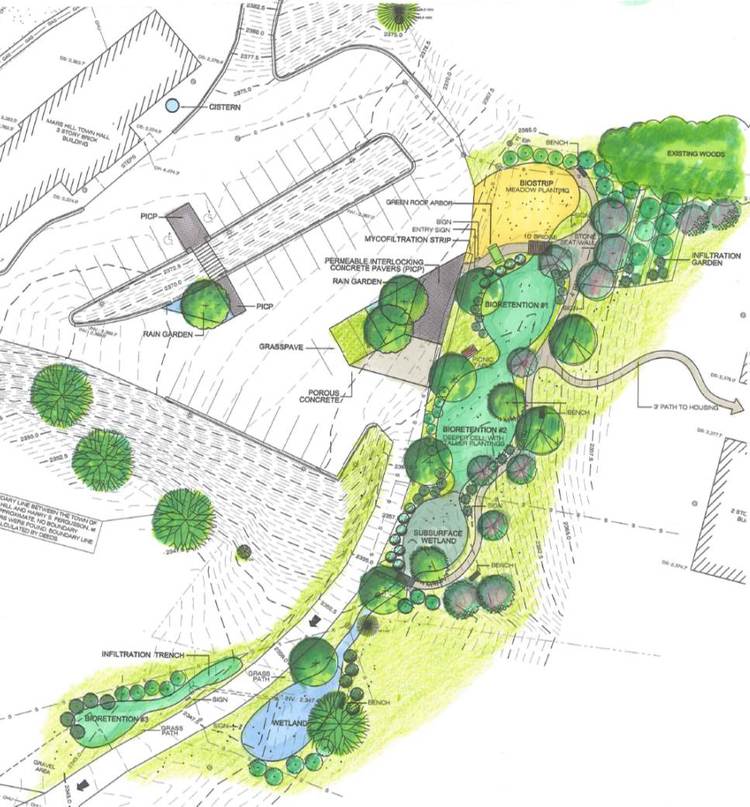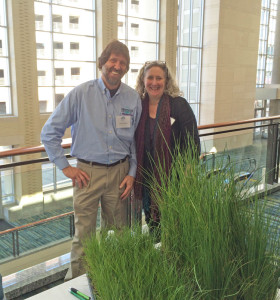Making Stormwater Interesting and Beautiful
The Hoffmans tour a public park that demonstrates the beauty and benefits of new techniques for controlling stormwater runoff and reducing water pollution.
Read Post Hoffman Nursery recently sponsored the NC Low Impact Development Summit, and it gave us an exciting look at the future.
Hoffman Nursery recently sponsored the NC Low Impact Development Summit, and it gave us an exciting look at the future.
Stormwater Affects Just About Everything.
It determines what can be built on a site, the position of structures on the site, the cost, how it looks, and a whole host of factors. The way we deal with stormwater has changed dramatically, with an emphasis now on mimicking natural hydrologic processes and treating stormwater at its source. This new approach can reduce the effects of increased development while improving our surroundings. For background on green infrastructure and low impact development (LID), see our recent post. For more info on costs, jobs, and economic potential of LID, see presentations by LID pioneer, Larry Coffman, and Tracy Davis, Director of the NC Division of Energy, Mineral, and Land Resources.

LID Features Across the State
Some of the most engaging presentations were on LID projects throughout the state. Presenters from coastal, central, and mountain regions talked project challenges, innovative techniques they used, and ways to overcome obstacles. In one of the largest projects, the Sierra Nevada Brewing Company is building its east coast brewery in the mountains of North Carolina. Their site incorporates rainwater harvesting for reuse, permeable pavers, and infiltration devices. They’re incorporating solar panels, and the facility will be built to at least LEED Silver standards.
Developers from all three regions presented sites where they were able to fit more buildings on the site using LID features than they could with conventional stormwater features. The conventional way to handle the stormwater would have been to create large detention basins, which take up a lot of space on a site. LID features can be much smaller and work in tandem to do the same (if not better) job. That leaves more room for development and preservation of green space. In these projects, any increased costs from the LID features were offset by the increase in developed space. And they were able to increase the amount of green space at the same time.
For the Market at Colonnade, an urban project in Raleigh, the site couldn’t have handled the proposed development with conventional stormwater features. They had to use LID features in order to build what they wanted. They incorporated a massive underground infiltration system, rainwater harvesting for reuse, permeable pavers, and vegetated filter strips. They capture and reuse up to 300,000 gallons of stormwater runoff for site irrigation and plumbing.

Innovative Approaches
A public demonstration site in the small, mountain town of Mars Hill, NC was fascinating. They incorporated more than a dozen LID features into a 1.3-acre site. The public can read about the features and learn how they’re helping the community. They can also see which features could be used in a home landscape. The demonstration project also used a unusual feature—a mushroom mycelium filter strip that intercepts runoff from the parking lot. Moreover, the project incorporated permaculture principles. Get more information about this innovative project here.
Encouraging LID
Officials from the state’s stormwater division introduced a set of permitting tools to encourage the use of low impact development (LID) practices. To qualify for LID, the run-off from a site after it’s developed should be the same or less that it was before the site was developed. It’s a pretty basic concept, and it greatly simplifies the permitting process. The run-off calculations are computed automatically with the online tool, so designers can see the effects of the LID features on the site.

Moving Ahead
Hoffman Nursery collaborated with several green industry groups to survey participants about the role of plants in LID and green infrastructure. The response was very encouraging, and we’re working on a report that outlines economic development and research opportunities for the green industry. Stay tuned for more on that as we continue to collect data.
Finally, we want to thank the NC Coastal Federation for organizing the event. The work they do for North Carolina is important, and we are happy to support the new approaches they’re promoting. For links to PDFs of presentations at the conference, click here.
Get Current Availability: Excel Download |PDF Download